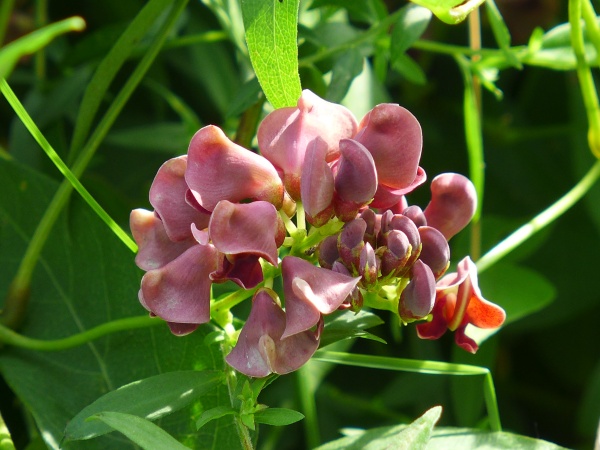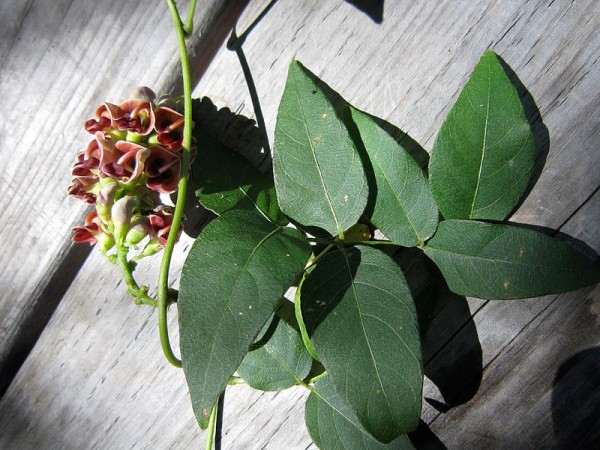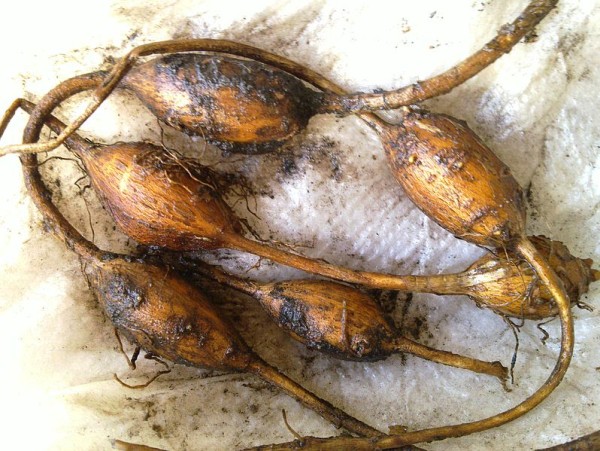
These mauve-brown flowers aren’t big and showy but they have a place in American history.
American groundnut (Apios americana) is a perennial vine in eastern North America with tuberous roots that are good to eat. Many Native American tribes cultivated the plant, dug the roots and ate them like potatoes. The Lenape people called them “hobbenis” or hopniss.

When Europeans arrived in North America they knew nothing of the plant but learned quickly from the natives to avoid starvation. The Wampanoag taught the Pilgrims where to find it and how to cook it. It was probably on the menu at the first Thanksgiving.
Here’s what a freshly dug harvest looks like:

Europeans took hopniss back to the Old World and tried raising it as a crop, but the projects were soon abandoned because Apios americana doesn’t grow well in monocultures and it isn’t large enough to harvest until it’s two to three years old.
More recently the wild foods community has rediscovered hopniss but its desire to grow with other plants — and engulf them — is frustrating to tidy gardeners.
This month is a good time to see American groundnut in the wild.
It’s blooming now in western Pennsylvania.
Note: If you decide to forage for this plant get permission from the landowner before you begin. This goes for public lands too. For instance, it is illegal to take flowers, plants and animals from Pittsburgh City parks and Allegheny County parks.
(flower photo by Kate St. John. Remaining photos from Wikimedia Commons; click on the images to see the originals.)
And state parks too!
Just to note, this state forest regulations document
http://www.apps.dcnr.state.pa.us/forestry/sfrmp/stateforestregs.htm
says (note the part I highlighted between the asterisks):
FOREST PRODUCTS
§ 21.31. Prohibitions.
The following activities are prohibited:
(1) Cutting, picking, digging, damaging or removing, in whole or in part, a living or dead plant, vine, shrub, tree or flower on State Forest land without written authorization of the District Forester or a designee, *except that edible wild plants or plant parts may be gathered without authorization if they are gathered for one’s own personal or family consumption*. Dead and down wood for small campfires may be gathered without prior authorization.
There is a long tradition of people gathering food for themselves on public lands in PA. I don’t believe they’ve restricted that yet. You can certainly eat berries, nuts, etc. in the woods. No gathering for commercial purposes without permits from the state.
Just to clarify, I found a newer copy of the regulations:
http://www.dcnr.state.pa.us/cs/groups/public/documents/document/dcnr_008795.pdf
You are still allowed to gather plant parts for personal consumption as long as they are not threatened or endangered. This rules revision is from earlier this year.
Thanks, Mary Ann.